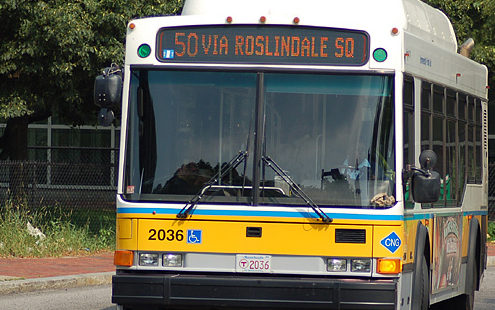
Transforming Urban School Districts through Choice
0 Comments
/
The Foundation for Education Reform & Accountability (FERA), based in Albany, New York, has been implementing a school-choice initiative — the Albany Project — that has created high-quality charter schools to serve more than half of the local public school student population in the state's capital city. FERA believes that a district composed of choice schools can better serve students, parents, and the community than the traditional urban school district system. The Albany Project is demonstrating that the charter school model — freedom from state regulations and education bureaucracy, freedom to innovate, and increased accountability—can better serve all students, not just the small segment of the population fortunate enough to win an enrollment lottery or afford a private school.

The Charter Agencies Initiative
Iowa's Charter Agencies Initiative, originally developed by the Public Strategies Group, a Minnesota-based government-consulting firm, is one in a series of programs implemented by Iowa Governor Tom Vilsack to ad-dress the ballooning state budget. The program stresses increased efficiency, reduced costs, and greater freedom for state agencies (and the Governor's office) to offer better value to Iowa's citizens.

The Performance Bonus Pay Program
Through its pay-for-performance program, the Dallas County (Texas) Motor Vehicle Division (MVD) has set an example for how similar agencies across the country could be reformed. MVD registers 1.9 million vehicles per year and has 140 employees at 10 sites. In March 1998, the Vehicle Registration and Title Department launched its performance pay program. The program utilizes performance measures to identify and reward quality work.

The Building Permitting Automation Efficiency Program
Buildings in Florida's Miami-Dade County typically fill up as quickly as they can be built. Between glimmering high-rise towers for vacationers or retirees, banks and offices that serve as the nerve centers of Miami's south-ward-looking economy, or schools and public buildings to support a growing population, South Florida has the look of a perpetual hard-hat zone. This steady pace of needed construction is maintained by an innovative building department and its Building Permitting Automation Efficiency Program.

The Bid-to-Goal Program
Bid-to-Goal is a program originally developed by the City of San Diego's Metropolitan Wastewater Department (MWWD), in conjunction with consulting firm Henningson, Durham and Richardson (HDR), in 1997 as an "optimization strategy" to more cost-effectively implement large public works initiatives. By means of a binding pact between the city and public sector employees, the MWWD had hoped to create a hybrid dynamic that incorporates the most desirable features of both public and private sector contracting.

Consolidating Off-Road Vehicle Registration
We propose to close all five Registration and Titling Bureau offices and al-low the RMV to register all motor vehicles—boats, ATVs and snowmobiles included. This consolidation would bring significant savings while actually improving service for off-road vehicle owners.

The Estuaries Project
The Massachusetts Estuaries Project, through the University of Massachusetts-Dartmouth School of Marine Science and Technology (SMAST), supports the Massachusetts Department of Environmental Protection (DEP) in the development and implementation of policies to protect nitrogen-sensitive coastal embayments. The Project collects data and develops models to manage and restore the 89 embayment systems that comprise the coastline of southeastern Massachusetts. The Project encompasses new technologies, regulatory approaches and funding mechanisms to reduce the costs of conducting estuarine restoration.

Our Legacy of Neglect: The Longfellow Bridge and the Cost of Deferred Maintenance
The Longfellow Bridge, connecting Boston and Cambridge, is in bad shape, due not only to its age and the ravages of our weather, but also to a troubling and persistent lack of maintenance. Fixing the bridge, in effect paying the bill for our unwillingness to maintain it, is estimated to cost at least $180 million, with the potential for cost overruns reaching into the hundreds of millions.

Managing Water Demand: Price vs. Non-Price Conservation Programs
This paper offers an analysis of the relative merits of price and non-price approaches to water conservation. As economists, we emphasize the strong empirical evidence that using prices to manage water demand is more cost-effective than implementing non-price conservation programs.

A Reform of Workers’ Compensation Insurance
The Massachusetts Department of Industrial Accidents has implemented numerous reforms that have improved the safety of workplaces throughout the state since Governor Mitt Romney’s election in 2002. In the process, the DIA has reduced the number companies that do not adhere to the state’s worker compensation laws.

A Reform of Wetlands Regulations
The cost of housing in Massachusetts absorbs too much of the average resident’s income and drives people and businesses out of the state. According to recent research studies, the problem is not a lack of land but an excess of regulation. I propose a concrete and politically palatable policy reform to ensure that septic and wetland regulations are used to protect the environment and public health. This reform would remove the temptation for towns to misuse these rules to discourage development.

Housing and Land Use Policy in Massachusetts
Restrictive regulations have undermined the market’s ability to meet demand, such that homebuyers have dramatically bid up the prices of a limited supply of housing over the last 25 years.

Rehabbing Urban Redevelopment
This report surveys 14 Massachusetts cities outside the immediate Boston metropolitan market, which other studies have identified as “weak market” or “gateway” cities. While useful designations, this report employs the term “Middle Cities.”

Housing Programs in Weak Market Neighborhoods
This paper will focus on programs that subsidize the building or rehabilitation of units for owner occupancy, as opposed to the development of rental properties. Most weak market neighborhoods already feature a high proportion of renters and high rates of vacancy.

Beyond the Gas Tax: Defining Transportation Needs, Emphasizing Economic Growth, and Maintaining Our Assets
Our goal in this paper is to highlight how current thinking on transportation is needlessly and wastefully constrained by the bureaucratic structures of the past. To maximize the region’s economic potential and conserve scarce fiscal resources, transportation planning needs to be objective, transparent, and data driven.

Public Pensions
While the pension system is not overly generous for typical employees, it is riddled with exceptions, ambiguities, and loopholes that allow some of them to abuse the system and collect unwarranted benefits, resulting in tremendous cost to the state and ultimately to taxpayers. The root of these problems is that the calculation of benefits is not based on the simple concept of contributions but the complicated interplay of four factors—years of eligible service, maximum three years of compensation, "group" or job classification, and retirement age.

Leaving Money on the Table: The 106 Pension Systems of Massachusetts Public Employee Benefits Series: Part 2
The focus of this paper is the choice that local retirement boards have of managing their own investors or investing all or a portion of their assets in PRIT. Most local boards choose to retain control of their investments. In 2004, 55 out of the 104 local systems invested entirely on their own, 29 had some assets invested in PRIT or the PRIT segmentation program, and only 20 invested entirely with PRIT.

Long-Term Leasing of State Skating Rinks: A Competitive Contracting Success Story
The state’s involvement with indoor skating arenas can be divided into distinct phases. Each phase offers lessons, not only about the evolution of competitive contracting, but also about the role of the private sector in the provision of public amenities.

Getting Home: Overcoming Barriers to Housing in Greater Boston
Few dispute the idea that Greater Boston faces a serious housing crisis that threatens the continued economic growth of the region. Evidence of a housing crisis in the Boston area includes high apartment rents, high home prices, and an insufficient supply of housing units. The lack of a varied housing stock prices many workers out of the market—and drives both households and businesses out of the region, including entrepreneurs and their colleagues who are engaged in the start-up phase of business.

Rationalizing Health and Human Services
Over the course of the past decade, thousands of organizations have used business process redesign and information technology to get to know their customers well, and they have used that information to do a better job of meeting their customers’ needs. Five years ago, anyone who had a checking account, a mortgage, an auto loan, and a credit card with the same financial institution might as well have been dealing with four different companies. Today, more often than not, that individual gets one statement each month that consolidates his or her entire relationship with that financial institution. The bank knows the extent of its relationship with each customer, and its customers can manage their accounts and loans in a unified, coordinated manner.

Competition & Government Services: Can Massachusetts Still Afford the Pacheco Law
The Pacheco Law was enacted by the Massachusetts legislature in 1993. The law, now M.G.L. ch. 7 sections 52-55, set up a series of tests that a state agency must pass before it can award a contract to a private company to perform services that had been previously performed by state employees.

A Declaration of Independence: Reaffirming the Autonomy of the Third Branch
This report explores the current budgeting and staffing process and the problems arising from it—striking productivity declines, rapidly rising costs, and, most importantly, systemic inequities in the distribution of resources.

Build More or Manage Better? Public Housing in Boston and Massachusetts
Increases in the price of rental housing in Massachusetts during the economic boom of the 1990s have spurred a push to construct additional subsidized housing.1 This report presents alternatives to construction that could significantly increase the available supply of subsidized housing. The study compares public and subsidized housing in Boston and the Commonwealth to other cities and states in terms of subsidized units per capita, vacancy rates, overhousing rates, and average tenancy tenure. The data indicate opportunities for both state and city housing authorities to manage more effectively the existing stock of public and subsidized housing.

The Boston Convention Center’s shrinking market
"The Boston Convention Center's shrinking market" was provided in May 2001.

Government Effectiveness Index: A Cross-State Survey
The central objective of the Government Effectiveness Index (GEI) is to assess how Massachusetts is doing in comparison to other states. It seeks to provide measures of effectiveness based on the efficient use of resources (inputs as a function of quantity or output) and on performance outcomes (quality of output). It does so in regard to eight “core” functions of state government (functions common to most states): K-12 education, higher education, highways, transit, state police, the judiciary, corrections, and financial administration.

Toward a High-Performance Workplace: Fixing Civil Service in Massachusetts
The civil service system in Massachusetts is no longer up to the important task of helping government recruit and hire the most talented personnel. When the system was created in 1884, the Commonwealth was at the forefront of the battle against patronage in government hiring. Over the course of a century, Massachusetts has fallen well behind the leaders in public sector personnel administration practice.

Flawed Forecasts: A Critical Look at Convention Center Feasibility Studies
An increasing number of American cities are pursuing an economic development strategy aimed at boosting convention and visitor activities. From Boston to Atlanta, San Antonio to San Francisco, cities are mounting massive construction projects to provide new or expanded convention center space.

The Cost of Inaction: Does Massachusetts Need Public Construction Reform?
The study then looks at potential savings from implementing alternative delivery methods that employ a quality- and price-based selection process, and found that the three other states have indeed benefited from their experiments with A+B Bidding and Partnering.

Missing the Bus: The Fight to Contract Competitively for MBTA Bus Service
Public transit agencies across the nation are struggling to control costs without reducing service. One effective strategy used by a growing number of public transit agencies is to contract competitively for bus operations. Almost without exception, these agencies report that private bus companies can deliver equal or better service at a 20 to 30 percent lower cost.

Public Profits from Private contracts: A Case Study in Human Services
Robert Melia, author of Pioneer's White Paper entitled Public Profits From Private Contracts and former vice president of Policy Studies, Inc, used child support enforcement as a case study to compare private versus public delivery of human services. Melia argued that competitive contracting is often a more effective way of delivering services not because public employees are inefficient or private companies pay less, but because bureaucratic checks and balances are inherent in government.
